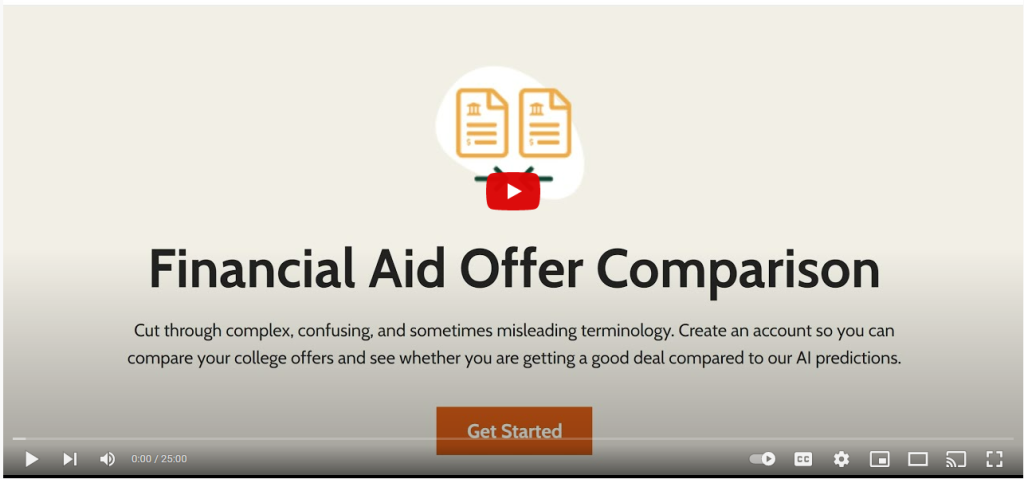Understanding financial aid award letters can be confusing – especially since colleges and other organizations don’t have a single format! Every letter you receive will be slightly different as they use different formats, terminology, and numbers. So how do you make sense of it?
This guide should be able to help!
Types of Financial Aid
First, it’s important to understand the different types of aid offered to you and what they mean for you, now and in the future.
Loans
Financial aid loans are money that is granted for college, collects interest, and needs to be repaid. Federal private loans fall under two categories: subsidized and unsubsidized. Direct subsidized loans don’t require repayment and don’t collect interest until six months after college graduation. Direct unsubsidized loans begin accruing interest immediately.

Scholarship
A scholarship on the financial award letter is a monetary award to students and does not have to be repaid in most cases. Hear that? FREE MONEY! These come from the college in question and can be merit-based, financial need-based, or based on other criteria. Some are one time only scholarships. Others are recurring – meaning you’ll get the award year after year as long as you still qualify.
It’s important to note the requirements for the scholarship before accepting. Some awards require students to maintain a certain GPA throughout their college experience, attend college full time, or stay within a particular program or major. Failing to do this could require the student to pay back the scholarship or, in the case of recurring awards, not be eligible for future years.
Grants
Grants are like scholarships as they do not have to be repaid. Hosted by federal, state, and local governments, these programs require the student to have completed the Free Application for Federal Student Aid (FAFSA). Grants from the federal government include the Pell Grant and Federal Supplemental Education Opportunity Grant (FSEOG).
Grants offered at the state level vary from state to state. Massachusetts, for example, offers the needs-based Gilbert Grant.
Federal Work Study
Federal Work Study is a program offered by the government where the student works on campus or near the school to help afford college. These jobs are part-time employment, but the positions fill up quickly and spots are not guaranteed.
What Financial Aid Terms Do You Need to Know?
To help you make sense of the financial aid letters, there are some terms you should know:
COA
Also known as the Cost of Attending or college costs, this number is the estimated total cost of attending a particular college. Not all schools list this number on their award letters, however.
The COA will vary from school to school, of course, but how the COA is determined will also vary. The number always includes tuition, but some colleges include or omit other expenses including room and board, books, supplies, transportation, and other expenses.
EFC
The EFC, or Expected Family Contribution, is the number the federal government uses to determine financial aid eligibility. This is not necessarily the amount you would have to pay to attend the college.
Front-Loading Grants
It’s important to be able to identify “front-loading grants” on your award letter. These are grants that are only for the first year or two of attendance. This may make the third and fourth year financially difficult for you.
Preferred Lenders
If you’re in need of private loans, your college’s financial award letter may include recommendations for their preferred lenders. Although they come with that recommendation, that doesn’t mean you have to use them or even take out private loans. Shop around.
Net Cost
This is the cost of attendance minus the entire financial aid package.
Out-of-Pocket Cost
This is the cost of attendance minus “gift” aid (scholarships, work study, and grants). This is the amount you will actually pay in the long run as it includes loans.
How Can You Understand a Financial Award Letter?
Since every financial award letter you receive will be different from the next and the cost of attendance will vary from school to school, making sense of them can feel impossible. It’s important to first understand the true cost of attendance and what your college is offering you.
One of the easiest ways to understand your financial award letter is to use our Financial Aid Offer Comparison tool. By creating an account, you can get through all the complex information presented on the documents and get to the details that actually matter for your future. You can also compare offers you’ve received to see which is best for your buck!
There’s no doubt that financial award letters can be confusing. Going into the reading though with a solid understanding of the different terms and offerings will help you make sense of them. Understanding financial aid award letters can be confusing. Check out the recorded live demo of our Financial Aid Offer Comparison tool if you’re struggling to make heads or tails of the letters.
| Lender | Rates (APR) | Eligibility | |
|---|---|---|---|
 |
5.34%-15.96%* Variable
3.99%-15.61%* Fixed
|
Undergraduate and Graduate
|
VISIT CITIZENS |
 |
4.92% - 15.08% Variable
3.99% - 15.49% Fixed
|
Undergraduate and Graduate
|
VISIT SALLIE MAE |
 |
4.50% - 17.99% Variable
3.49% - 17.99% Fixed
|
Undergraduate and Graduate
|
VISIT CREDIBLE |
 |
6.00% - 13.75% Variable
3.99% - 13.75% Fixed
|
Undergraduate and Graduate
|
VISIT LENDKEY |
 |
5.50% - 14.56% Variable
3.69% - 14.41% Fixed
|
Undergraduate and Graduate
|
VISIT ASCENT |
 |
3.70% - 8.75% Fixed
|
Undergraduate and Graduate
|
VISIT ISL |
 |
4.99% - 16.85% Variable
3.47% - 16.49% Fixed
|
Undergraduate and Graduate
|
VISIT EARNEST |
 |
5.00% - 14.22% Variable
3.69% - 14.22% Fixed
|
Undergraduate and Graduate
|
VISIT ELFI |






